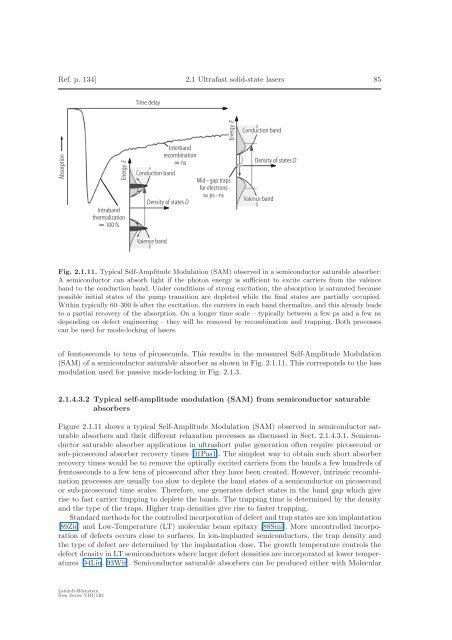2.1 Ultrafast solid-state lasers - ETH - the Keller Group
2.1 Ultrafast solid-state lasers - ETH - the Keller Group
2.1 Ultrafast solid-state lasers - ETH - the Keller Group
You also want an ePaper? Increase the reach of your titles
YUMPU automatically turns print PDFs into web optimized ePapers that Google loves.
Ref. p. 134] <strong>2.1</strong> <strong>Ultrafast</strong> <strong>solid</strong>-<strong>state</strong> <strong>lasers</strong> 85<br />
Time delay<br />
Energy E<br />
Conduction band<br />
Absorption<br />
Energy E<br />
Intraband<br />
<strong>the</strong>rmalization<br />
≈ 100 fs<br />
Conduction band<br />
Interband<br />
recombination<br />
≈ ns<br />
Density of <strong>state</strong>s D<br />
Mid−gap traps<br />
for electrons<br />
≈ ps−ns<br />
Density of <strong>state</strong>s D<br />
Valence band<br />
Valence band<br />
Fig. <strong>2.1</strong>.11. Typical Self-Amplitude Modulation (SAM) observed in a semiconductor saturable absorber:<br />
A semiconductor can absorb light if <strong>the</strong> photon energy is sufficient to excite carriers from <strong>the</strong> valence<br />
band to <strong>the</strong> conduction band. Under conditions of strong excitation, <strong>the</strong> absorption is saturated because<br />
possible initial <strong>state</strong>s of <strong>the</strong> pump transition are depleted while <strong>the</strong> final <strong>state</strong>s are partially occupied.<br />
Within typically 60–300 fs after <strong>the</strong> excitation, <strong>the</strong> carriers in each band <strong>the</strong>rmalize, and this already leads<br />
to a partial recovery of <strong>the</strong> absorption. On a longer time scale – typically between a few ps and a few ns<br />
depending on defect engineering – <strong>the</strong>y will be removed by recombination and trapping. Both processes<br />
can be used for mode-locking of <strong>lasers</strong>.<br />
of femtoseconds to tens of picoseconds. This results in <strong>the</strong> measured Self-Amplitude Modulation<br />
(SAM) of a semiconductor saturable absorber as shown in Fig. <strong>2.1</strong>.11. This corresponds to <strong>the</strong> loss<br />
modulation used for passive mode-locking in Fig. <strong>2.1</strong>.3.<br />
<strong>2.1</strong>.4.3.2 Typical self-amplitude modulation (SAM) from semiconductor saturable<br />
absorbers<br />
Figure <strong>2.1</strong>.11 shows a typical Self-Amplitude Modulation (SAM) observed in semiconductor saturable<br />
absorbers and <strong>the</strong>ir different relaxation processes as discussed in Sect. <strong>2.1</strong>.4.3.1. Semiconductor<br />
saturable absorber applications in ultrashort pulse generation often require picosecond or<br />
sub-picosecond absorber recovery times [01Pas1]. The simplest way to obtain such short absorber<br />
recovery times would be to remove <strong>the</strong> optically excited carriers from <strong>the</strong> bands a few hundreds of<br />
femtoseconds to a few tens of picosecond after <strong>the</strong>y have been created. However, intrinsic recombination<br />
processes are usually too slow to deplete <strong>the</strong> band <strong>state</strong>s of a semiconductor on picosecond<br />
or sub-picosecond time scales. Therefore, one generates defect <strong>state</strong>s in <strong>the</strong> band gap which give<br />
rise to fast carrier trapping to deplete <strong>the</strong> bands. The trapping time is determined by <strong>the</strong> density<br />
and <strong>the</strong> type of <strong>the</strong> traps. Higher trap densities give rise to faster trapping.<br />
Standard methods for <strong>the</strong> controlled incorporation of defect and trap <strong>state</strong>s are ion implantation<br />
[89Zie] and Low-Temperature (LT) molecular beam epitaxy [88Smi]. More uncontrolled incorporation<br />
of defects occurs close to surfaces. In ion-implanted semiconductors, <strong>the</strong> trap density and<br />
<strong>the</strong> type of defect are determined by <strong>the</strong> implantation dose. The growth temperature controls <strong>the</strong><br />
defect density in LT semiconductors where larger defect densities are incorporated at lower temperatures<br />
[94Liu, 93Wit]. Semiconductor saturable absorbers can be produced ei<strong>the</strong>r with Molecular<br />
Landolt-Börnstein<br />
New Series VIII/1B1
















